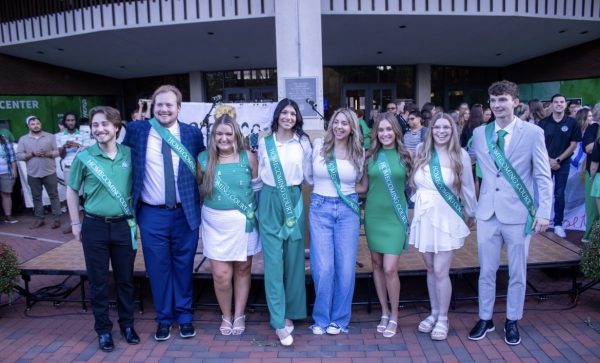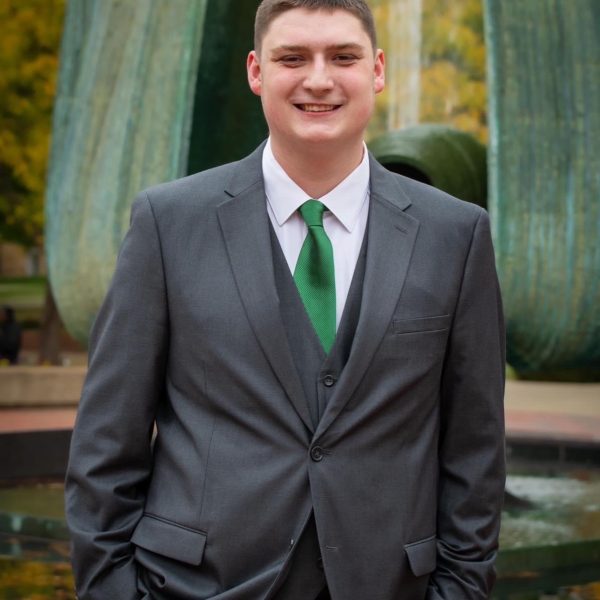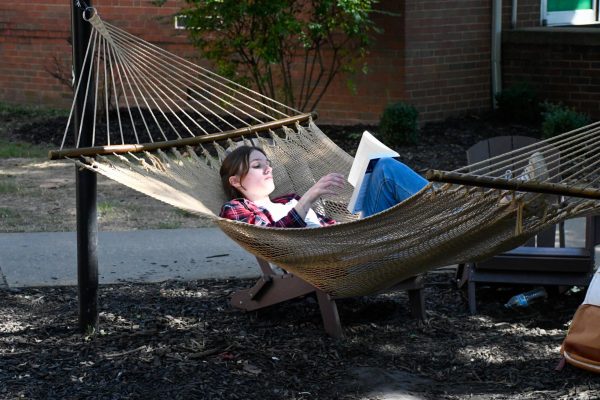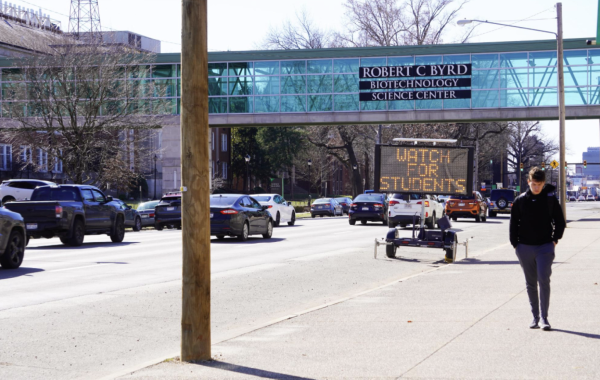A walk in the wild: Marshall University students combine research and leisuire on the Appalachian Trail
FROM LEFT TO RIGHT: Rachel Sparkman, Kristi Fondren, Lindsay Heinemann and Meghan Arnold gather at a trail head in Damascus, Virginia, the site of Trail Days. Trail Days features a variety of activities for those interested in the Trail, including parades, talent shows and free nightly outdoor concerts.
Students looking to scratch a particular itch can get outside this summer and experience the Appalachian Trail through a class called Field Experience in Applied Sociology taught by Dr. Kristi Fondren.
Students can earn college credit researching the subculture associated with hikers of all different kinds while spending time on the premiere long-distance hiking trail in the United States. Fondren said the class grew from a series of questions she had regarding subcultures and what she calls the “subculture of place.” Fondren started teaching the class in 2011.
“I guess I first took three graduate students, one in history and two in sociology, and one just wanted me to do it, so we did this as an independent study and I thought this was a good opportunity to see how it might work out — one made it out of the three,” Fondren said. “They thought they could do it, but you get out there and you’re dirty and hot and sweaty, I mean, it’s work — you just have to be comfortable being uncomfortable.”
Fondren said she has been learning a lot since the initial venture into the 2,200-mile trail. She takes feedback from students to better adapt the course as the years progress. Although Fondren changes bits and pieces of the plan, the class always centers around one event called Trail Days in Damascus, Virginia. The 31st annual Trail Days is May 19, 20 and 21 this summer.
“So, normally the class has only been taught in that May intercession, now I’m able to teach it the first summer term that goes two months, so now we have more time to do stuff during the semester,” Fondren said. “Typically what I’ve done because of the length of the class is for those who want to hike, and it’s encouraged, but it’s not required — ‘cause I think you just get a feel for what hikers go through if you do it even for two or three days — but usually we would drive over that Monday and start hiking around noon. We hike south into Trail Days. That first day is about five or so miles give or take. The next three days, cause it’s about 31 miles or so into Trail Days, we hike about eight to ten miles a day and we usually make it shelter to shelter. We hike into Damascus Thursday. That’s important to me so that we can get a good spot before people crowd in Friday — and there’s still stuff going on Thursday — Friday is just a day to do whatever there. Saturday is the day they have a Hiker Parade and a Hiker Talent Show. There’s all these gear people set up, musicians, there’s plenty of things to do — and then, the class would be over in the past cause we only have that month of May to do it anyways. Often, I stay out on the trail and keep hiking. If anybody wants to they can.”
Fondren said the best way to really learn about the subculture of the Appalachian Trail is to really be immersed in the experience, hiking with hikers and speaking to peers along the way. Fondren said the trail’s subculture is specifically unlike other subcultures she had researched in the past.
“There’s plenty of leisure subcultures and, in what I was able to research, it was the activity that brought people together and not necessarily the place,” Fondren said. “So windsurfing was a big one that came up in the beginning. There was a huge windsurfing subculture, but there wasn’t this one body of water that seemed to unite people that they all would come to and it seemed like the trail was that though for hikers, and the Appalachian Trail more specifically. As far as research questions, that’s what I want to figure out. So, is it a marriage of place and activity or is it just a more general long distance hiking subculture and place doesn’t matter as much? I’m trying to figure that out.”
Fondren said the hiking subculture is one of the strongest ones she’s researched and even if hikers don’t particularly think they have a trail identity, those perceptions are still very much there.
“Hikers develop a hiker identity that’s created or constructed by them in their community, but also by outsiders in terms of how they react to hikers — so that reinforces a hiker identity even if you didn’t think you had one when outsiders treat you differently when you come into town to resupply and you’re stinky, and smelly — the way they respond helps to construct that identity,” Fondren said. “I would say hikers no matter the trail share that — you know, the unkempt appearance, the life of poverty, you’ve given up everything to hike, you’re determined, you persevere despite the weather and blisters — so they are kind of a different breed of character.”
Fondren said the connection to the trail itself is where place shows up for her.
“But to me, place shows up when, and so many hikers tell me this, when the trail just becomes you,” Fondren said. “I ask if hikers get this itch, if they’ve been in town too long — even at trail days I asked this person and they said ‘yeah, I’ve only been in town four or five days but I’m already getting that itch’ — but the trail becomes you, so not only do they develop this hiker identity, but there’s this trail identity where they’re so connected to the place not just the people. Hiking is an embodied experience so every step you take your body feels it and you’re conscious of that. It’s hard to understand that part without actually hiking. I mean, you can be around the community, but you won’t know what it’s like to experience that.”
Students interested in the course do not need to meet any pre-requisites, but Fondren said there will be a few opportunities for students to meet her and others taking the course. It is then students will discuss logistics with Fondren and get a better idea of the physical workload they’re about to endure. In the past, Fondren said she would often gather with students in areas like Lake Vesuvius to experience a shorter go at the same kind of work they would be putting on during the expedition.
“You’ll have one group one year where everything goes smoothly and then the next year you’ll say ‘ahh, we should’ve done this differently,’” Fondren said. “Sometimes it’s just the dynamic and the makeup of the students in the class.”
The ultimate goal of the course is to have students create their own research projects pertaining to the subculture of place and how it rears its head on the Appalachian Trail. Students spend time with hikers, learning things about their subculture firsthand. Fondren said the real challenge comes when there is a variety of students taking the course.
“It’s hard to prepare for something like that if you’ve never been, but I thought something like that could give students a better sense of how it’s done,” Fondren said. “People also hike at different paces and that’s a concern I have, cause only you can hike your hike. Even just going with my husband, we go at different paces. He’s faster on the uphill, but I like to stop and breathe, but I can pass him coming down. When students are out there though, I feel that extra responsibility. I think a good idea is trying to pair people up so at least they’re with somebody from the group. I mean, you’re going to see people out there, you wouldn’t be alone out in the middle of nowhere — if something were to happen, someone would always get word to me if I were ahead or behind. My husband has gone with me in the past and he might hike with the faster people out front, but I know from experience that if you feel like you’re forced to hike someone else’s pace and you’re miserable, that’s when you’re not going to want to be there. So there’s that fun balance of hike the pace that’s comfortable – and we’ll know, there’s kind of an itinerary – we would know how many miles we’re going to hike a day and what shelters we’re going to stop at. If you see a stream, or you’re the kind of person that likes to draw nature scenes, you’re out there for your reasons too. If you want to stop and take pictures, you can’t pet the ponies, but if you want to sit out there and enjoy the view, you can.”
Fondren said a big selling point about the course is the bonds it often facilitates between student to student and even student to teacher.
“You really get to know people in a different way than you do in the classroom, I can tell you that,” Fondren said. “I’d say Trail Days in general, but the one grad student who stayed with me the first year we did this is a good friend today because of the experience we shared together. The night that stands out to me the most, it was really cold and I think that was part of the reason the other two decided to hike back in, but she and I at Thomas Knob Shelter, it was so cold it was like a Tim Burton movie — dark, dreary, fog everywhere — it was freezing. You get up to this place and its cold and the loft, this shelter had an upstairs, unlike most of the ones on the trail, but the upstairs was already occupied, so she and I are on the bottom where it’s open. We had to get creative. We were hanging up our rain flies to block the wind from blowing in, we had to cuddle that night — I mean you really get to know the people you’re with — it’s that bonding — those experiences you go through like that kind of create those bonds. She and I have hiked even since she’s graduated. She’s met me before and hiked 100 miles or so.”
Students are required to bring their own gear, but Fondren said sometimes hikers will share amenities when necessary. She also said students can rent equipment from the Rec Center for a nominal fee.
As far as students nervous to take a serious hiking milestone, Fondren said it is important not to take everything too seriously.
“When people say they load their backpacks down with sand and rocks and stuff like that around their neighborhoods, I mean, if you want to do that, you can do that — I still think just doing it is the best,” Fondren said. “I don’t prepare, I don’t work out a lot before I go, I just kind of slow and steady wins the race. I would say don’t go out there thinking it’s going to be easy, but just, you know, one step at a time. We’ll plan as far as where we’re going and what sort of food we need to take and that kind of stuff but just be willing to let some of that go. You want to get away from structure and routine to an extent. When I feel like it’s a job I’m like ‘Woah, it’s time for me to go home.’ I’m there for the wrong reasons if I feel like its work. Be flexible. Be comfortable being uncomfortable. Don’t take everything in the world you think you might need. Sometimes you just learn the hard way — you’ll carry it in and realize ‘next time I go hiking, I’m leaving that at home.’”
Students interested in taking the course can contact Dr. Fondren at fondren@marshall.edu.
Will Izzo can be contacted at izzo@marshall.edu.
Your donation will help continue the work of independent student journalism at Marshall University. If you benefit from The Parthenon's free content, please consider making a donation.







